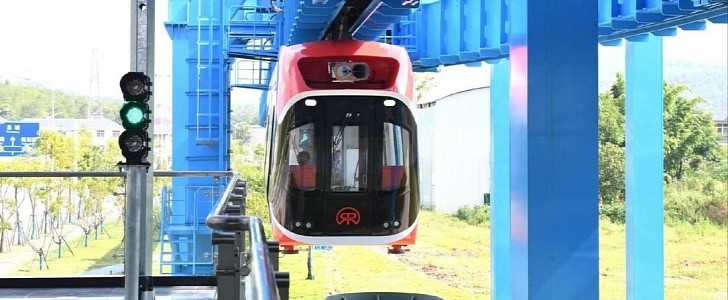China is at the forefront of innovation in terms of train technology. In the last decades, we’ve seen its railway network, which is the largest in the world, expand and improve with leading smart train technology and automation. And the country isn’t showing any signs of slowing down as it continues to invest in its nationwide transportation options.
Now, China scores another first in the field with a new type of train technology - a suspended maglev rail that uses permanent magnets to allow the train to float on its track without using power.
The transportation project, called “Red Rail,” is an experimental magnetic levitation line that promises a faster, quieter, greener, and cheaper maglev. The pilot line is 800 meters (2,600 feet) long and has been completed in Xingguo County, Jiangxi Province, South China.
Unlike other existing trains, the newly launched “Sky Train” makes use of permanent magnets instead of electromagnets to produce a constant buffering force, and that allows it to float approximately 10 meters (32.8 feet) above the ground. Basically, an arm attached to the maglev train surrounds the railway, and permanent magnets in said arm and the rail push apart, thus managing to keep the train suspended. The free-floating and no-friction conditions being met, the train will be propelled and kept floating using only a small amount of electricity, as explained by researchers at Jiangxi University of Science and Technology.
The levitating train includes two units with a total of 32 seats and is capable of operating with 88 passengers on board.
According to South China Morning Post, the maglev train operates with no physical contact with the rail, moving beneath it at 80 kph (50 mph). But that’s the speed set for this phase of the pilot project. In the second phase of the test, when the line is expected to be fully operational, the train’s speed will improve to 120 kph (74.5 mph). The rail will also be extended to 7.5 km (4.7 miles).
The research and development for the “Red Rail” transportation system took nine years to complete, and the engineers who worked on the suspended line say they expect the project to become a high-quality, individualized and intelligent transportation system, considering it’s smart, green, safe, and cost-effective.
The transportation project, called “Red Rail,” is an experimental magnetic levitation line that promises a faster, quieter, greener, and cheaper maglev. The pilot line is 800 meters (2,600 feet) long and has been completed in Xingguo County, Jiangxi Province, South China.
Unlike other existing trains, the newly launched “Sky Train” makes use of permanent magnets instead of electromagnets to produce a constant buffering force, and that allows it to float approximately 10 meters (32.8 feet) above the ground. Basically, an arm attached to the maglev train surrounds the railway, and permanent magnets in said arm and the rail push apart, thus managing to keep the train suspended. The free-floating and no-friction conditions being met, the train will be propelled and kept floating using only a small amount of electricity, as explained by researchers at Jiangxi University of Science and Technology.
The levitating train includes two units with a total of 32 seats and is capable of operating with 88 passengers on board.
According to South China Morning Post, the maglev train operates with no physical contact with the rail, moving beneath it at 80 kph (50 mph). But that’s the speed set for this phase of the pilot project. In the second phase of the test, when the line is expected to be fully operational, the train’s speed will improve to 120 kph (74.5 mph). The rail will also be extended to 7.5 km (4.7 miles).
The research and development for the “Red Rail” transportation system took nine years to complete, and the engineers who worked on the suspended line say they expect the project to become a high-quality, individualized and intelligent transportation system, considering it’s smart, green, safe, and cost-effective.








